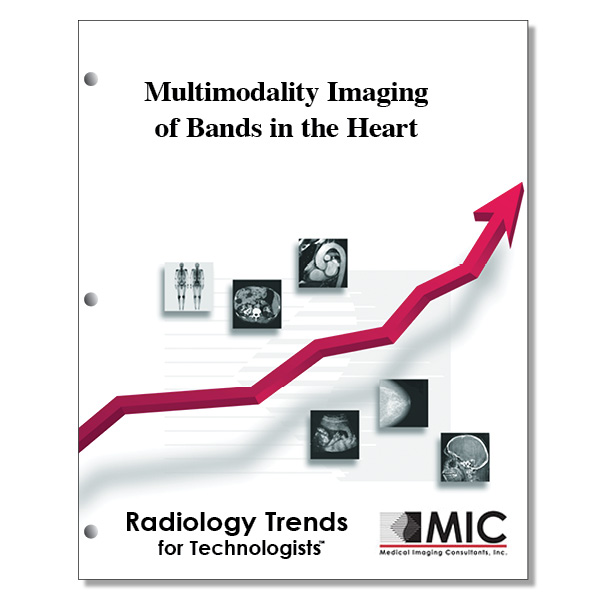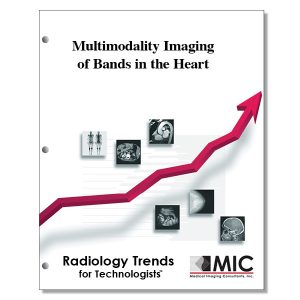

Multimodality Imaging of Bands in the Heart
A review of various bands and band-like structures within the cardiac chambers, as well as the role of imaging in depicting the bands, their appearances with various imaging modalities, and their clinical significance.
Course ID: Q00592 Category: Radiology Trends for Technologists Modalities: Cardiac Interventional, CT, MRI, Sonography3.25 |
Satisfaction Guarantee |
$34.00
- Targeted CE
- Outline
- Objectives
Targeted CE per ARRT’s Discipline, Category, and Subcategory classification for enrollments starting after January 27, 2023:
Cardiac-Interventional Radiography: 3.25
Procedures: 3.25
Diagnostic and Electrophysiology Procedures: 3.25
Computed Tomography: 3.25
Procedures: 3.25
Neck and Chest: 3.25
Registered Radiologist Assistant: 3.25
Procedures: 3.25
Thoracic Section: 3.25
Outline
- Introduction
- Imaging Modalities
- Normal Structures and Variants
- Crista Terminalis
- Taenia Sagittalis
- Chiari Network
- Coumadin Ridge
- Moderator Band
- Papillary Muscles and Chordae Tendineae
- Aberrant Structures
- Aberrant Papillary Muscles
- Accessory Chordae Tendineae
- Accessory Mitral Valve Tissue
- Aberrant Ventricular Bands
- Aberrant Atrial Bands
- Pathologic Entities
- Double-chambered RV
- Double-chambered RA
- Cor Triatriatum
- Subaortic Stenosis
- Shone Complex
- Conclusion
Objectives
Upon completion of this course, students will:
- know which cardiac bands and bandlike structures are usually asymptomatic
- be familiar with the various types of bands in the heart
- know the most frequent result of cardiac pathologic entities
- identify the common clinical scenarios in which imaging is involved in cardiac band diagnosis
- know the first-line imaging modality used in the evaluation of the heart
- understand the reasons why a patient might be referred for further imaging after the completion of the first-line imaging of the heart
- be familiar with the advantages, disadvantages, and indications for utilizing the various imaging modalities in the evaluation of cardiac bands
- be familiar with how cardiac band normal variants and other structures are typically depicted on MR imaging
- know what is essential for dynamic and functional information in cardiac CT imaging
- understand how a thrombus can be characterized and distinguished from a neoplasm in CT imaging
- recognize some basic facts about the crista terminalis
- distinguish thrombus from crista terminalis at MR imaging
- be familiar with the pattern types of the taenia sagittalis muscle
- understand how taenia sagittalis is visualized at medical imaging
- be familiar with the broad spectrum of possible Chiari network manifestations
- recognize both the possible protective role that a Chiari network might have, as well as the potential clinically significant conditions to which it could lead
- know how a Chiari network presents at imaging
- know the more familiar nomenclature for the left lateral ridge of the left atrial wall between the left superior vein and left atrial appendage
- know how to distinguish the left lateral ridge from a pathologic entity on CT and MR imaging
- identify the reason behind the nomenclature of the moderator band
- recognize the functions of the moderator band
- be familiar with how the moderator band is depicted at imaging
- know the location at which a prominent or hypertrophied moderator band can be confused with a thrombus on echocardiography
- be familiar with the basic anatomic structure and location of papillary muscles
- understand the conditions resulting from papillary muscle variances
- be familiar with how the Berdajs system classifies papillary muscles at imaging
- identify the various types of aberrant papillary muscle anomalies
- be familiar with the conditions caused by the various types of aberrant papillary muscle anomalies
- know how MR imaging benefits the assessment of aberrant papillary muscles
- indicate how the various aberrant papillary muscle anomalies are depicted at imaging
- understand the potential clinical symptoms of accessory chordae tendineae
- be familiar with how accessory chordae tendineae appear at imaging
- identify the insertion locations for the chordae tendineae of AMVT
- know the potential clinical symptoms of AMVT
- be familiar with some of the basic anatomy and morphology of aberrant ventricular bands
- specify the clinical conditions which can arise from a false tendon
- be familiar with the various types of false tendons
- understand how an aberrant atrial band demonstrates at imaging
- be familiar with how double-chambered RV demonstrates at imaging
- know how a double-chambered LV differs from a double-chambered RV
- know the cardiac chambers in which cor triatriatum sinister and cor triatriatum dexter would be located
- specify the morphologic types of cor triatriatum dexter
- be familiar with the morphologic and prevalence information about subaortic stenosis
- understand what imaging information is important for subaortic stenosis surgical decision making
- know which imaging techniques can demonstrate the various left-sided obstructive cardiovascular lesions associated with shone complex
